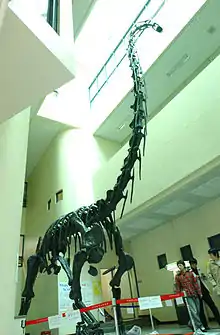Pukyongosaurus
Pukyongosaurus (meaning "Pukyong lizard", after the Pukyong National University[1]) is a genus of titanosauriform dinosaur that lived in South Korea during the Early Cretaceous period (Aptian - Albian). It may have been closely related to Euhelopus, and is known from a series of vertebrae in the neck and back.[2] The characteristics that were originally used to distinguish this genus have been criticized as being either widespread or too poorly preserved to evaluate, rendering the genus an indeterminate nomen dubium among titanosauriforms.[3]
| Pukyongosaurus | |
|---|---|
 | |
| Reconstructed skeleton of Pukyongosaurus | |
| Scientific classification | |
| Kingdom: | Animalia |
| Phylum: | Chordata |
| Clade: | Dinosauria |
| Clade: | Saurischia |
| Suborder: | †Sauropodomorpha |
| Clade: | †Sauropoda |
| Clade: | †Eusauropoda |
| Clade: | †Neosauropoda |
| Clade: | †Macronaria |
| Clade: | †Titanosauriformes |
| Genus: | †Pukyongosaurus Dong et al., 2001 |
| Type species | |
| Pukyongosaurus millenniumi Dong et al., 2001 | |
Discovery
In 2001, several fragments of a sauropod skeleton were discovered in the Hasandong Formation in Hadong County, South Korea.[4] Seven incomplete cervical vertebrae, one dorsal vertebra, a partial clavicle, one chevron, and other small bones and bone fragments were found.
One of the caudal vertebrae ascribed to Pukyongosaurus has bite marks from theropod teeth.[4]
References
- http://www.paleofile.com/Dinosaurs/Sauropoda/Pukyongosaurus.asp
- Dong, Z.M.; Paik, I.S.; Kim, H.J. (2001). "A preliminary report on a sauropod from the Hasandong Formation (Lower Cretaceous), Korea". In Deng, T.; Wang, Y. (eds.). Proceedings of the Eighth Annual Meeting of the Chinese Society of Vertebrate Paleontology. Beijing: China Ocean Press. pp. 41–53.
- Park, J.-Y. (2016). "Comments on the validity of the taxonomic status of "Pukyongosaurus" (Dinosauria: Sauropoda)" (PDF). Memoir of the Fukui Prefectural Dinosaur Museum. 15: 27–32.
- Kim, J. Y.; Huh, M. (4 January 2018). "Dinosaurs of Korea". Dinosaurs, Birds, and Pterosaurs of Korea. Singapore: Springer: 84, 88. doi:10.1007/978-981-10-6998-7_2.












